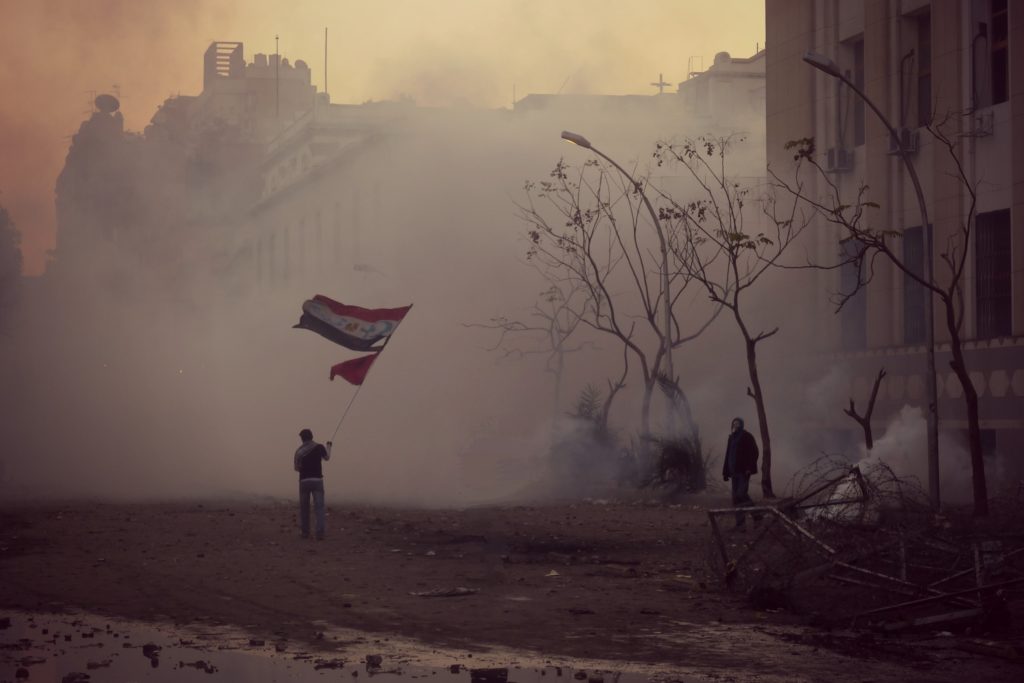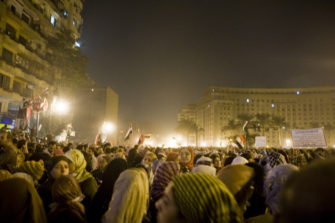
Revolution was far from my mind when I first began ruminating about martyrs, miracles, and wonderwork in Egypt. Doing fieldwork during Mubarak’s last decade felt like an exercise in hunting for the new in the old. I soon discovered myself and my research caught up in an exhilarating timeline of uprisings and overthrow, followed soon after by hellish rounds of arrests, torchings, and massacres. My ethnography similarly hints at vacillations between promise and despair, beginning with courageous protests for change and ending with fears of terrorism. Even as I write this, I am battling doubts that saints have anything to do with the things that “really” matter: soaring poverty, crushing protest bans, and a steely leader set on staying in power until 2030. Mega-cathedrals are being built by Sisi and martyrs are being given military funerals. The holy in hindsight looks like yet another sign of authoritarianism’s come-back with a vengeance.
In their generous reflections on my book, my three readers—Kathryn Lofton, Rachel Smith, and Anand Taneja—explore the holy without forfeiting the necessary critique of violence. Brimming with vivid glimmers of insight, they show how worlds of divine imagination exceed repression and bloodshed behind the scenes. More remarkable is how they manage to do this while holding in view the coercive realities of Egypt’s authoritarian present. What lies between the ecstatic thrill of miracles and the brute force of militarization? Whether it takes the form of generative excess or dialectical tension, the instability of the saint-state relation supplies some release from the overdetermining forces of counterrevolution. It is on the revolutionary subject of saint-state instability that I engage with my readers’ comments here.
Rachel Smith makes the wonderfully bold case that remembering the holy dead is wildly anachronistic. In a provocative reversal of my book’s last line, she argues for the possibility that anachronism is a “living, labile force of the present.” Herself a historian of hagiography, Smith is familiar with anachronism’s lowly, even mortally sinful, state in secular historiography. Martyrs and mystics in contemporary Egypt roam wildly, as do medieval Europe’s forgettable laywomen who lie outside the sciences of preservation. Smith upholds the strange potency of devotion and the unruly persistence of memory across periods and traditions of valuing the dead. I see her also speaking to a frequent gripe that I’ve encountered in the field: much to their disadvantage, Copts are too caught up in the ancient era of glorious martyrs and the bloody reproduction of violence. “Saints have nothing to do with what is going on now,” so the secularists say. Hence, the political charge against anachronism: traditions that austerely boast two millennia of the same old rituals risk losing sight of the ever-shifting present of revolution and counterrevolution.
The radical malleability of memory is a truly frightening force in times of tumultuous change. More than any other incident of violence against Copts, the Maspero Massacre of 2011 was powerful proof that the military was (and is) far from a steady, trustworthy ally for Copts and their future security. On October 9, 2011, demonstrations at the Maspero television tower ended with Egyptian army soldiers in APCs attacking protestors with live ammunition. Only a few years later, in 2014, I was startled by several Copts who claimed that it was the Muslim Brotherhood who had stolen the tanks and trammeled over protestors in the guise of army soldiers. How do we assess the politics of such a wildly anachronistic account? How do we make sense of this complete 180 in the crucial game of political accountability, at one moment directed at the military state and at another, theatrically away from it?
For now, the answers seem to lie within Egypt’s timeline of shifting political tides: in 2012, Mohamed Morsi was elected to the presidency, and in 2013, General Abdel Fattah al-Sisi booted him out. In the secular dialectic of revolution and counterrevolution, national contexts of authoritarian rule overdetermine the symbolic value of dead bodies. Combating this historicist genre of predeterminism, Smith’s essay revives the rebellious potential of anachronism. The out-of-time quality of saints is what makes their resignification feel plentiful and abundant in empty historical time. Martyr memorialization does not conform, weirdly and wildly, to the linear march of secular national history. Here is where I find Smith’s final provocative reversal to be revelatory. As she puts it toward the end of her response, “Secularism is more truly anachronistic insofar as it is not in sync with the vicissitudes of time.”
On the question of time, Anand Taneja has also journeyed to the edges of religious tradition where Delhi’s secular history is out of sync with miracles in its medieval ruins. Or, perhaps it is precisely the jarring capacity of miracles to sync up with postcolonial history that energizes his response. In his attentive reading of holy images from Egypt, Taneja picks up where I begin, with the iconic Virgin of the Apparition and its curiously overlooked origins in foreign Catholicism. Yes, there is Egypt’s authoritarian making of the Arab Virgin and post-1967 Christian-Muslim unity. The Virgin of Zaytun is solidly assimilated into national-sectarian history. Yet, Taneja daringly opens up an extrinsic, indeed “foreign,” angle on the whole enthusiastic affair of populism and mass politics. What about those genealogies of the French Virgin and the photographic Virgin that arrive “unbidden, out of the corner of one’s eye”? Experiments in political theology call for blurring genres of secular and religious imagination. Joining Taneja, I have also been thinking about the Paris protests in May 1968.

Just last week, I was giving a talk on the Virgin of Zaytun, when a person in the audience declared after viewing the photos: “This looks like a protest!” Resonating with the spirit of revolution, her observation got us all thinking about the choreography of crowds and the assembly of people that “appear” to come out of nowhere. No one saw Tahrir coming. For all their laws of prediction, the sciences of social movements and state politics did not forecast the 18-day rush that brought the 30-year Mubarak regime down. In hindsight, it was not only the rush of energy but also the terrors of repression and the horrors of bloodshed under Mubarak’s long rule that brought holy images into historical consciousness.
Repression is the topic that Kathryn Lofton takes up to tackle secularism sideways. If Taneja is searching in the corner of your eye, Lofton is craning toward your sotto voce. The wonder-working underground—of dusty baraka and unassuming oils—is slow and quiet. If there is any political critique to be heard from beneath and beyond, it is one that emerges from far-flung mechanisms of silencing and hiding. Lofton submits her acute intuitions on repression: “The more the miraculous, oil-exuding religious is routed away from the public, the more the public starves for real religious feeling.” Irrepressible intimacy! Defying secularist impulses to divide and separate, feelings for the real broker relations not only between the I and Thou, but also between Christians and Muslims under sectarian rule. Here is where I hear Lofton’s appeal to radical discontent and its sociological powers to overcome repression on multiple registers. If you catch me on a more cynical day, I may even say outright that human desires for holy mystery and saintly masquerade only further reinforce and shore up systems of repressive rule.
Since wrapping up my fieldwork in 2015, Sisi’s brutal crackdown on dissent has solidly returned Egypt into the military’s hands. What this has meant is the military’s subsuming of martyr memory within its authoritarian annals of history, not to mention the systemic repression of social movements and mass mobilization. Like my fellow scholars of religion here, I am dissatisfied with reading religion as the mere fodder for manipulation and control. The major challenge remains a deeper understanding of what religion and political theology can enact beyond the authoritarian state’s grip. I sign off from this reply now, a couple weeks after a rare round of September protests erupted across Egypt and only a few days before the eighth anniversary of the Maspero Massacre. Here’s to the impending possibility of contending modernities in real time.

